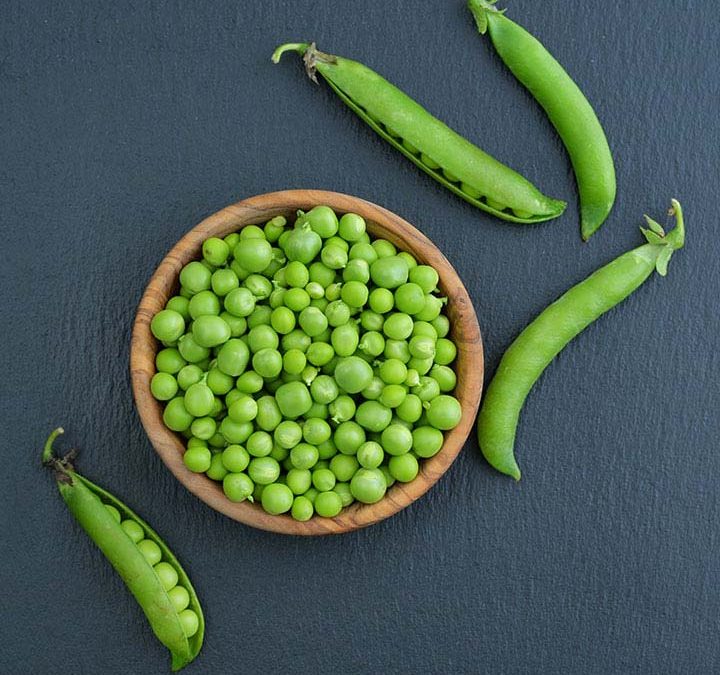The benefits of green peas make them a must-have addition to your diet. They are packed with dietary fiber, starch, protein, vitamins, and beneficial phytochemicals.
The high protein content of green peas makes them an ideal option for vegans and vegetarians. They are generally regarded as a complete protein source as they have the full complement of essential amino acids. However, one is low (methionine), so it is wise to consume them with foods that are richer in this amino acid, such as rice or eggs. This article discusses the benefits of green peas, their nutritional profile, and any potential side effects. Take a look.
What Are Green Peas?
The green pea or garden pea (Pisum sativum) is the seed of the plant that grows in hard pods. It is a type of legume and a climbing annual plant that originated from Southeast Asia. It is an important food legume, ranking fourth in the world in terms of legume production (1).
Green peas are featured across several cuisines. They are consumed raw, boiled, steamed, or their pods are stir-fried. Their starch content makes these legume seeds mildly sweet.
The peas are nutritious and wholesome, as do most legumes. Learn more about green pea’s nutritional value below.
Green Peas Nutrition Facts
In the following section, we will explore the major health benefits of green peas.
Health Benefits Of Green Peas
1. May Help Manage Blood Sugar And Diabetes
Green peas contain complex carbohydrates that are good for managing blood sugar levels (3). They have a low glycemic index as they are rich in starch and fiber.
Foods with a low glycemic index help release the sugar into the blood slowly. This helps regulate blood sugar levels. Low GI foods are beneficial in the prevention and management of type 2 diabetes (3).
In mice studies, raw pea extracts could inhibit the activity of a particular enzyme (pancreatic amylase) involved in carbohydrate metabolism. This could explain the hypoglycemic effect of pea extracts in mice (4). More studies are needed to understand the anti-diabetic effects of green peas.
2. May Improve Digestion
Peas contain prebiotic sugars and fiber that may be beneficial in the digestive process. The galactose oligosaccharides in peas were found to help with the digestion in the large intestine (5).
Prebiotic sugars become fodder for the probiotic bacteria during digestion. This helps the good bacteria to use these sugars and convert them to products that are beneficial to our body.
The dietary fiber present in peas helps in improving the digestive function (5). Fiber helps in the movement of food through the digestive tract. This is essential for proper digestion and elimination of toxic substances.
Pea sprouts also have antimicrobial effects. The phenolic extracts of sprouted peas inhibited the growth of Helicobacter pylori, the ulcer-causing bacteria (6). Including green peas in the diet can improve the overall gastrointestinal function.
3. May Help Lower Blood Cholesterol Levels
Green peas have high fiber content. Propionate, a product of fiber fermentation, was found to lower blood cholesterol levels in rats (7). Managing cholesterol levels can help prevent cardiovascular diseases.
An excess of low-density lipoprotein, or LDL, is harmful to the body. It clogs the arteries and may lead to heart disease. In studies on pigs on a high cholesterol diet, peas reduced their plasma levels of total and LDL cholesterol (8). The soluble fiber in green peas may also lower the risk of cardiac disease.
4. May Help Reduce Inflammation
Chronic inflammation and oxidative stress can lead to cardiovascular disorders, neurological disorders, and cancer. Hence, it becomes increasingly important to include anti-inflammatory foods in our diets as we age in order to manage inflammation (9). The powerful antioxidant and anti-inflammatory properties of green peas can fight oxidative damage and may help reduce cancer risk (10). These antioxidants bind to free radicals and reduce their ill effects on the body.
Extracts of peas exhibited anti-inflammatory activity in animal studies (11).
5. May Help Reduce The Risk Of Cancer
The legume family of plants is known for being rich in anti-cancer compounds. Green peas contain certain inhibitors that have shown to reduce the risk of colon cancer (12).
Several other compounds in green peas, such as lectins and saponins, have also exhibited anticancer activity (13). Studies have shown that isoflavones and phenolic compounds present in green peas have anticancer effects on liver, colon, lung, and breast cancer cells (1).
6. Good Source Of Antioxidants
Green peas are packed with potent antioxidants such as phenolic compounds. They contain tannins that have shown to have a high antioxidant activity (5). These beneficial compounds protect our cells from damage and early cell death. Antioxidants help scavenge free radicals and reduce the risk of chronic health complications (14).
Given the health benefits of green peas, it is wise to include them in the diet. They are easy to add into meals and are readily available to purchase or you can grow your own. However, peas may not suit everyone, and it is possible that they may cause certain side effects in some people.
Side Effects Of Green Peas
Green peas may lead to side effects in certain individuals. Always consult a doctor before making any changes to your diet.
Green peas contain anti-nutrients like phytic acid and lectins that may interfere with nutrient absorption. These anti-nutrients may also cause digestive problems (15), (16).
The phytic acid in peas may hamper the absorption of minerals like iron and zinc (17). This can eventually lead to nutritional deficiencies.
Lectins present in fresh peas can disturb the delicate balance of the immune system and bacterial population in the gut (16).
However, soaking, fermenting or cooking peas can potentially reduce these antinutrients (18). Also, reducing the portion size of peas can help decrease the risk of side effects.
In order to avoid further health complications, it is important to store and select green grams properly. Good produce will help you get the nutrients you need, and good storage will extend its shelf life. Here’s how to pick and store green peas effectively so they last as long as possible.
How To Select And Store
Throughout the year, you can find green peas in canned or frozen forms. Fresh peas are available in particular seasons, mainly in April.
Here’s what to look for when picking and storing fresh peas:
If you choose canned or frozen peas:
The health benefits of green peas can be attributed to their rich nutrients, fiber, and protein. They are replete with phytonutrients and essential amino acids too. They can be added to your favorite salads, soups, or dishes. Intake of green peas may help manage blood sugar levels, improve digestion, and protect against chronic diseases. However, excess intake of green peas may cause digestive issues as they contain anti-nutrients. Hence, consume them in moderation to enjoy their maximum benefits.
However, be wary of their antinutrients. These can be reduced by soaking, fermenting, or cooking them. Prepare them properly and you will be able to enjoy the benefits of the peas to the maximum.
Frequently Asked Questions
Are peas good for weight loss?
Peas are high in protein and low in fat and may aid weight loss. Their fiber content promotes satiety.
Can green peas make you gain weight?
There is insufficient information available in this regard. Although some argue that the high starch content in peas may lead to weight gain, there is no research to support this statement. Consult your doctor before including green peas in your weight loss/weight gain regime.
How long do green peas take to cook?
It takes 2- 3 minutes to cook green peas. You can add the peas to water and bring them to a boil.
How do you cook green peas fast?
You can use a microwave to cook green peas fast.
Are green peas a complete protein?
Green peas are not a complete protein as they lack a few vital amino acids.
Are green peas good for skin?
Green peas are a good source of vitamin C and antioxidants. These help with collagen production and promote skin health. Vitamin C may also help reduce dark spots on the skin and promote an even complexion, although research is limited in this regard.
How to eat peas?
Peas can be eaten fresh or cooked. They go well with rice dishes, pastas, curries, and patties. Frozen green peas or canned green peas can also be incorporated into recipes instead of fresh green peas. Mashed peas are popular as baby food.
Are peas safe for everyone to eat?
Possibly. Peas are healthy and may benefit your health. Nevertheless, you may be allergic to them, or the presence of antinutrients may cause stomach issues. Hence, practice caution.
Key Takeaways
- Green peas are a popular nutritious legume packed with proteins, fiber, and beneficial compounds.
- They contain powerful anti-inflammatory and antioxidant compounds that may enhance your overall health.
- They may help manage blood sugar levels, boost digestive health, and reduce the risk of chronic health complications.
Shirley Briars
(RN, DipION, mBANT, CNHC)
This content was originally published here.

